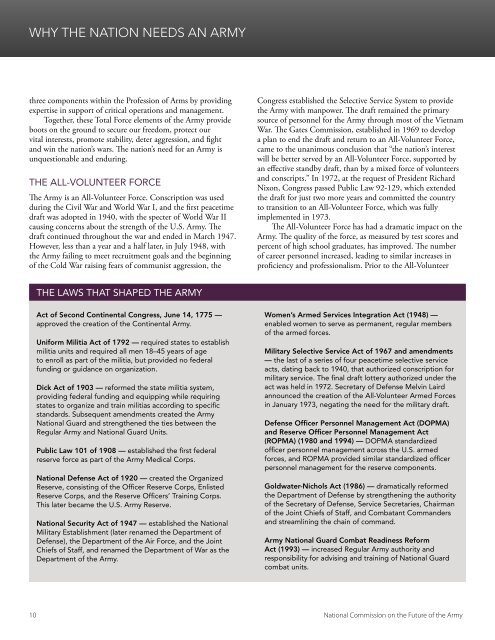THE FUTURE OF THE ARMY
1PlAz6L
1PlAz6L
You also want an ePaper? Increase the reach of your titles
YUMPU automatically turns print PDFs into web optimized ePapers that Google loves.
WHY <strong>THE</strong> NATION NEEDS AN <strong>ARMY</strong><br />
three components within the Profession of Arms by providing<br />
expertise in support of critical operations and management.<br />
Together, these Total Force elements of the Army provide<br />
boots on the ground to secure our freedom, protect our<br />
vital interests, promote stability, deter aggression, and fight<br />
and win the nation’s wars. The nation’s need for an Army is<br />
unquestionable and enduring.<br />
<strong>THE</strong> ALL-VOLUNTEER FORCE<br />
The Army is an All-Volunteer Force. Conscription was used<br />
during the Civil War and World War I, and the first peacetime<br />
draft was adopted in 1940, with the specter of World War II<br />
causing concerns about the strength of the U.S. Army. The<br />
draft continued throughout the war and ended in March 1947.<br />
However, less than a year and a half later, in July 1948, with<br />
the Army failing to meet recruitment goals and the beginning<br />
of the Cold War raising fears of communist aggression, the<br />
Congress established the Selective Service System to provide<br />
the Army with manpower. The draft remained the primary<br />
source of personnel for the Army through most of the Vietnam<br />
War. The Gates Commission, established in 1969 to develop<br />
a plan to end the draft and return to an All-Volunteer Force,<br />
came to the unanimous conclusion that “the nation’s interest<br />
will be better served by an All-Volunteer Force, supported by<br />
an effective standby draft, than by a mixed force of volunteers<br />
and conscripts.” In 1972, at the request of President Richard<br />
Nixon, Congress passed Public Law 92-129, which extended<br />
the draft for just two more years and committed the country<br />
to transition to an All-Volunteer Force, which was fully<br />
implemented in 1973.<br />
The All-Volunteer Force has had a dramatic impact on the<br />
Army. The quality of the force, as measured by test scores and<br />
percent of high school graduates, has improved. The number<br />
of career personnel increased, leading to similar increases in<br />
proficiency and professionalism. Prior to the All-Volunteer<br />
<strong>THE</strong> LAWS THAT SHAPED <strong>THE</strong> <strong>ARMY</strong><br />
Act of Second Continental Congress, June 14, 1775 —<br />
approved the creation of the Continental Army.<br />
Uniform Militia Act of 1792 — required states to establish<br />
militia units and required all men 18–45 years of age<br />
to enroll as part of the militia, but provided no federal<br />
funding or guidance on organization.<br />
Dick Act of 1903 — reformed the state militia system,<br />
providing federal funding and equipping while requiring<br />
states to organize and train militias according to specific<br />
standards. Subsequent amendments created the Army<br />
National Guard and strengthened the ties between the<br />
Regular Army and National Guard Units.<br />
Public Law 101 of 1908 — established the first federal<br />
reserve force as part of the Army Medical Corps.<br />
National Defense Act of 1920 — created the Organized<br />
Reserve, consisting of the Officer Reserve Corps, Enlisted<br />
Reserve Corps, and the Reserve Officers’ Training Corps.<br />
This later became the U.S. Army Reserve.<br />
National Security Act of 1947 — established the National<br />
Military Establishment (later renamed the Department of<br />
Defense), the Department of the Air Force, and the Joint<br />
Chiefs of Staff, and renamed the Department of War as the<br />
Department of the Army.<br />
Women’s Armed Services Integration Act (1948) —<br />
enabled women to serve as permanent, regular members<br />
of the armed forces.<br />
Military Selective Service Act of 1967 and amendments<br />
— the last of a series of four peacetime selective service<br />
acts, dating back to 1940, that authorized conscription for<br />
military service. The final draft lottery authorized under the<br />
act was held in 1972. Secretary of Defense Melvin Laird<br />
announced the creation of the All-Volunteer Armed Forces<br />
in January 1973, negating the need for the military draft.<br />
Defense Officer Personnel Management Act (DOPMA)<br />
and Reserve Officer Personnel Management Act<br />
(ROPMA) (1980 and 1994) — DOPMA standardized<br />
officer personnel management across the U.S. armed<br />
forces, and ROPMA provided similar standardized officer<br />
personnel management for the reserve components.<br />
Goldwater-Nichols Act (1986) — dramatically reformed<br />
the Department of Defense by strengthening the authority<br />
of the Secretary of Defense, Service Secretaries, Chairman<br />
of the Joint Chiefs of Staff, and Combatant Commanders<br />
and streamlining the chain of command.<br />
Army National Guard Combat Readiness Reform<br />
Act (1993) — increased Regular Army authority and<br />
responsibility for advising and training of National Guard<br />
combat units.<br />
10 National Commission on the Future of the Army


